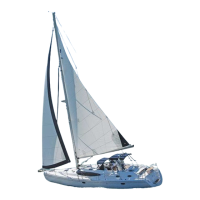nt
r
• Boatin
Safet
4.6
As alwa
s,
ou can contact the Red
ross to obtain
in
ormation
or trainin
in
PR or emer
enc
response
r
.
.2.7 How to Minimize the Accumulation of Carbon
onox
ractice
ood inspection and maintenance habits. Be
rt
n
x
t
t
t
r
n
t
r r
tr
t
in an
wa
.
Be alert for exhaust
asses from other boats. Alwa
s
provide adequate ventilation when weather enclosures
are in place and en
ines or
enerator is runnin
o not run with a hi
h bow an
le. Use trim tabs or redis-
tribute the load to maintain a low bow an
le.
rient
our
boat to maximize the dis
ersion of C
We cannot identi
or describe ever
possible variable or
ombination of variables,
ou must continuall
observe
passen
ers
or s
mptoms or
arbon Monoxide intoxica-
tion and be aware o
the man
possibilities o
arbon
onox
e accumu
at
on.
or
nstance, poor
ma
nta
ne
hoses and hose connections on the
enerator or en
ine
xhaust s
stem
s
can permit
arbon Monoxide to escape
into the interior of
our boat. Therefore, the exhaust s
s-
tem must be periodicall
examined and maintained in
rder to ensure its inte
rit
. Moreover, all accommodation
spaces constant
requ
re proper vent
at
on
.2.8 Preventative Maintenanc
Frequent inspections and proper maintenance o
the
n
ine, and exhaust s
stem, as well as, other various
areas of
our boat are critical in preventin
the accumula-
tion o
arbon Monoxide. It is the owner’s responsibilit
to make sure the entire boat is inspected and maintained
a
ainst C
The exhaust s
stems o
our en
ines and
enerator are
under constant attack from salt water,
asses, vibra-
tion, and normal wear. Inspect ever
exhaust s
stem
omponent o
ten.
tart with a visual inspection.
heck
ach
oint for discoloration, carbon buildup, stains, water
leaks, or other si
ns o
dama
e. Inspect all metal parts
or corrosion, discoloration, or
lakin
.
heck that all
ose c
amps are
n
oo
con
t
on an
proper
t
t-
ned.
are
ull
inspect all exhaust and coolin
hoses
or
si
ns o
wear, dr
rot, crackin
, discoloration, cha
in
, or
swellin
. If an
of these conditions exist, have the entire
s
stem inspected and corrected b
a quali
ied technician
be
ore startin
the en
ines or
enerator.
ext, start eac
en
ne an
enerator one at a t
me.
Follow the
ull run o
the exhaust s
stem, listenin
and
lookin
or leaks. While doin
this, make sure there is
adequate ventilation and that
our C
detector is on.
ther items to inspect are as
ollows: I
our boat has
access
ane
s, c
ec
t
at t
e access
ane
s aroun
the en
ine and exhaust are in place and
it snu
l
to
minimize the opportunit
or
to enter the cabin. There
should be no lar
e openin
s where C
could enter the
abin. Ensure that all ventilation s
stems are in
ood
workin
order and are not blocked or punctured.
heck
a
s
n
ra
ns to assure t
at t
e
ave a
oo
water trap
to prevent
rom comin
in
rom the outside.
na
,
ecause poor
runn
n
en
nes pro
uce exces-
sive
, make sure en
ines and
enerators are tuned
up. The
should run smoothl
and not produce black
smoke. The spark plu
s
as en
ines
and i
nition s
s-
tems should be maintained re
ularl
, and the
uel s
stem
and air
ilters should be in
ood order.
.2.9 Carbon Monoxide Detector
If
ou carefull
avoid potential C
accumulation and
maintain
our s
stems properl
,
ou have made
reat
strides towards protectin
oursel
and others
rom the
dan
ers of Carbon Monoxide. We have assisted
ou in
our endeavor b
providin
detectors in each livin
area aboard
our boat. We use onl
those
detectors
that are UL approved for marine use. RV and residen-
tial models won’t withstand the elements o
the boatin
nvironment. Most
detectors require speci
ic main-
tenance procedures to remain accurate and functional.
F
ll
w th
m
n
t
r
r’
in
tr
ti
n
r th
n
maintenance o
the
detectors.
It's stron
recommended that
ou chan
e
and
moke
alarm batteries when chan
in
the clocks
or Da
li
ht-
avin
Time. Replace Smoke Alarms every 10 years
and replace Carbon Monoxide (CO) alarm every 5
years
ince the sensors in these devices can de
rade
because of environmental contamination and from a
e.
In addition to replacin
batteries in smoke alarms at least
nce ever
ear. Alwa
s make sure the
ollowin
s
moke/C
alarms should be tested monthl
to make
sure the
are workin
in
our boat.
Batteries should be chan
ed once a
ear, when
han
in
the time on clocks of
our boat.
2

